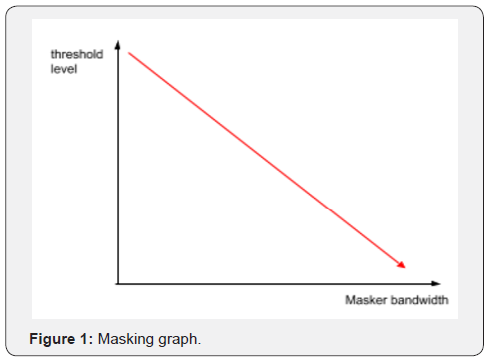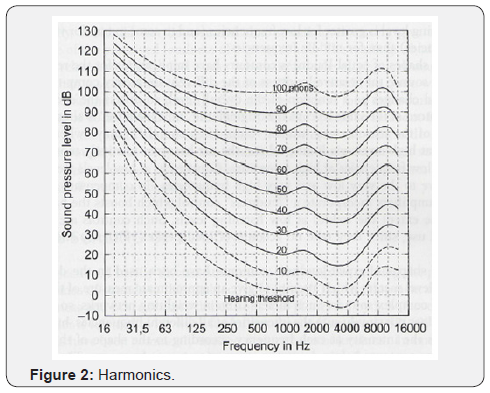Perceiving Auditory Stimuli: Inter-Species Adaptation Differences, Harmonics, and Illusions - Juniper Publishers
Juniper Publishers - Open Access Journal of Engineering Technology
Abstract
Illusions give us insights regarding how
physiological systems use and weigh information fromdifferent inputs.
Physiological systems interpret data in in such a way that we can
understand allof it as a whole concept. We will discuss and understand
these processes, as well as thetechnical processes that convert stimuli
to electrical impulses in the human auditory system. Wewill propose
experiments, explain evolutionary adaptations to improved hearing in
other species,explain harmonics and Weber’s law relating perception and
stimuli[1].
Keywords: Illusions; Physiological systems; Visual inputs; Evolution; Environment; Potential predators; Vibrations; Specific frequenciesCognitive Improvements
Illusions give us insights regarding how
physiological systems use and weigh information fromdifferent inputs.
Physiological systems interpret data in in such a way that we can
understand allof it as a whole concept.
In some cases, that leads to our brain creating
illusions by applying the wrong conceptualgrouping, for example, to the
available stimuli[2]. Physiological systems assign more weight tovisual
inputs, for example, and the brain groups auditory or visual stimuli
based on location andsimilarity to create a virtual model of the
perceived world. Attention changes depending on thesituation, as our
interpretation of stimuli has developed via evolution.
Illusions can be very artificial and controlled by
humans, but some are also common in naturalsettings. An example is that
many animal species can camouflage themselves in theirenvironment,
giving the illusions to potential predators or preys that the animal is
part of thebackground or environment. Some species such as the chameleon
can also change the color oftheir skin to adapt to different
environments.
The Process of Hearing
When a pressure wave reaches the ear, it transforms
to an electrical signal, which leaves theauditory nerve for higher
neural levels. First, the pressure wave enters the outer ear, composedof
the auditory canal and the pinna, then goes through the meatus, causing
tympanic membranevibrations. The eardrum then
transmits the vibrations to the cochlea via the ossicles, which aresmall
bones in the middle ear[3].
The ossicles in the middle ear are used to decrease
reflections caused by a difference inimpedance. The cochlea, which is in
the inner ear and is shaped as a spiral filled with a fluid,goes from
the base to the apex (the tip), has two membranes (the basilar membrane
andReisner’s membrane). At the base, there is the oval window, and at
the apex, there is anopening between the walls of the cochlea and the
basilar membrane, connecting the outerchambers of the cochlea (scala
tympani and scala vestibuli).
The physical vibrations wave reaches the basilar
membrane, which Von Bekesy discovered thatvibrates and transfers the
wave to the apex. As the fluid moves through the endolymph andperilymph,
the waves stimulate the receptor cells that send nerve impulses to the
brain. In theorgan of Corti, the four rows of hair cells between the
tectorial membrane and the basilarmembrane are depolarized by the
basilar membrane.
The inner hair cells transform fluid vibrations into
electrical signals that are sent through theauditory nerve to the
auditory brainstem and the auditory cortex, while outer hair cells are
usedto amplify soft sounds in the cochlea. Their electromotility is an
amplifier that mechanicallyincreases hearing sensitivity in specific
frequencies that are important to hear.
The hair cells release neurotransmitters at synapses
with the auditory nerve fibers, creatingaction potentials, which convert
the vibrations in the basilar membrane to firing
patternstransmitted to the brainstem.
Experiment
It is possible to measure a critical band by masking a sine
wave with a white noise band. Bydecreasing the bandwidth
of the white noise until the sinewave is identified, the band
widthreaches the critical bandwidth. Hereis a graph showing the
hypotheticaloutput of this test.By adding another noise band at
adifferent critical band, as long as it ismodulated in the same way
as thefirst noise band, the brain wouldidentify the pattern and be
able toseparate them from the sine wavewhich is not modulated
in the sameway. This could further lower thethreshold(Figure 1).

There are multiple types of masking: Simultaneous masking,
when a sound is maskedby another sound that is played during
the entirety of the first sound. Non-simultaneousmasking is
when a sound cannot be interpreted by the human brain because
another soundhas been played very soon before or after, and it
causes the illusion of having been part of thesame group and is
therefore masked[4].
Evolutionary Adaptations
There are species with evolutionary adaptations that
have enabled them to hear in remarkablyunique ways. Dogs
have evolved in such a way that they can move their ears in
differentdirections to capture and amplify sounds from those
directions[5]. Some owls cannot move theireyes, which means
they can more easily map vision to hearing, and thus have a
stronger spatialconnection between vision and audition[6].
Bats have evolved to the point of being able to echolocate
their preys and environment[7]. Somehumans are also able to
achieve this. Some insects have also learned to hear these sounds
thatbats emit. For example, some butterflies can sense these
vibrations in their wings, which makethem drop to the ground
and avoid being captured[8].
Harmonics
Case study I- 40 thermal-generator lossless system without wind power
The perception of a 100 Hz Sawtooth wave, if all the odd
harmonics are removed, will remain asawtooth wave but in
the next harmonic (200Hz), because all the even harmonics for
100Hz areALL of the harmonics for the 200Hz wave.Therefore, it
will be exactly an octave higher.
In order to create the 60 phon curve, for exampleone would
have to play a 60dB tone at 1kHz, andthen play tones at other
frequencies and measurewhich volume intensity in dB would
perceptuallymatch the 1kHz 60dB initial tone. Thus, the curve
will always provide 60phons at anyfrequency (Figure 2). The
A level weighting was made for under 40phons, so a regular
classroom wouldneed to be measured with an A-level meter. For
a rock concert, C-level would be moreappropriate since it was
designed for louder sound, around 100phons.

Near Miss to Weber’s Law
The Near Miss to Weber’s law is when at high frequencies,
the law doesn’t apply anymore[9]. Itprobably occurs because at
high frequencies, loudness perception differences converge. This
islikely to be an effect of the nonlinear scale of sound perception.
For example, there is a higherfrequency separation between C3
and C4 than C4 and C5, and that could create a smallerdifference
in perceived volume difference, according to Steven’s Power
Law[10].
Conclusion
In conclusion, illusions can help shed light on the systems
and mechanisms that our brain usesto understand the
environment, by combining multiple auditory and visual clues
into a coherentrepresentation of the world.
We analyzed some of these systems and gave examples on
how the ear mechanism works,with the cochlea, going from the
base to the apex, hair cells and auditory nerve fibers. Finally,we
proposed future experiments to measure critical bandwidth for
masking of auditory cues.
See Other Papers by This Author:
1. Roitman Lucas Agudiez, Alex T, Sebastian T (2014)
Real-time visual subject tracking and classification by combining motion signal analysis and tridimensional-shape
feature classifiers with group-induction boosting algorithms.
SURJ: The Stanford Undergraduate Research Journal.
2. Roitman Lucas Agudiez, Kyoko S, Terry W, Kevin Di P,
Jeff (2016) A comparative analysis of Augmented Reality
technologies and their marketability in the consumer
electronics segment, Honors Thesis in Science, Technology
and Society: Innovation and Organizations, Stanford
University. Journal of Biosensors & Bioelectronics.
3. Roitman Lucas Agudiez, Zhang Y, Tan Z, Canfei He
(2014) Social Stratification and Residential Segregation
in Haidian District, Beijing, China. International Journal of
Economics & Management Sciences.
4. Roitman Lucas Agudiez, Eric Roberts (2013) The impact
and tradeoffs of technology, communism and inequality in
the fiction of Brave New World. Grin Verlag.
5. Roitman Lucas Agudiez, Daniel F, Julie T (2017) Playing
God: Eradicating Malaria and Mosquitoes in the Developing
World with Gene Drives and CRISPR/Cas9. Journal of
Nanomedicine and Nanoscience Research.
6. Roitman Lucas Agudiez, Anusha B, Tum C, Frank F,
Haque I, Johnny I, Anshul K (2016) Smarter initializations in
multi-modal neural networks to predict transcription factor
binding.
7. Roitman Lucas Agudiez, Michael S (2014) The new
Industrial Revolution: manufacturing with 3D Printers and
Polymer Materials in an Economy of Design, Innovation and
Intellectual Property. International Journal of Economics &
Management Sciences.
8. Roitman Lucas Agudiez, Mark V (2014) Copyright
Enforcement and Piracy Controls as an Excuse for Corporate
and Political Domination. Grin Verlag.
9. Roitman Lucas Agudiez, Kenneth S, Kerry P (2014)
Analyzing internal political factors that impact foreign
intervention decisions by the United States government.
10. Roitman Lucas Agudiez, Anshan Li, Suolao W (2014)
Chinese intervention in the Middle East: How could it shift
the balance of power? Grin Verlag.
11. Roitman Lucas Agudiez, Kenneth S, Kerry P (2014)
U.S. Intervention in Syria Intervention Will Take Place in
the Middle East during the Obama Administration. Global
Journal of Human-Social Science: Interdisciplinary.
12. Roitman Lucas Agudiez, Michael M, Tomoki Eto, Banny
B (2013) The Social Seat, an Urban Installation in the Age of
the Internet of Things
13. Roitman Lucas Agudiez, Zhang Y, Tan Z, Canfei He
(2014) Social Stratification and Residential Segregation
in the Urban Fringe: A case study of the Haidian District in
Beijing. International Journal of Economics & Management
Sciences
14. Roitman Lucas Agudiez (2014) Diaspora, the
decentralized social network as a technological utopian
libertarian ideal.
15. Roitman Lucas Agudiez (2014) An analysis of Sony
Corporation’s horizontal and vertical integration in the
Consumer Electronics market.
16. Roitman Lucas Agudiez, Canfei He (2014) The
Economic and Organizational mechanisms for the Regulation
of Urbanization in modern day China.
17. Roitman Lucas Agudiez, Poppy C (2014) Neuroplasticity
and the use of visual and auditory illusions for improving
musical and gaming abilities.
18. Roitman Lucas Agudiez, Marcelo C (2014) An
introduction to Microeconomic Principles and their
applications in multiple fields.
19. Roitman Lucas Agudiez, Jelena B, Eric R (2013) A social
and ethical analysis of Thomas More’s Utopia.
20. Roitman Lucas Agudiez, Michael S (2014) The
Management and Organizational role of Scribes as
Bureaucrats in Ancient Egypt.
For more articles in Open Access Journal of
Engineering Technology please click on:




Comments
Post a Comment